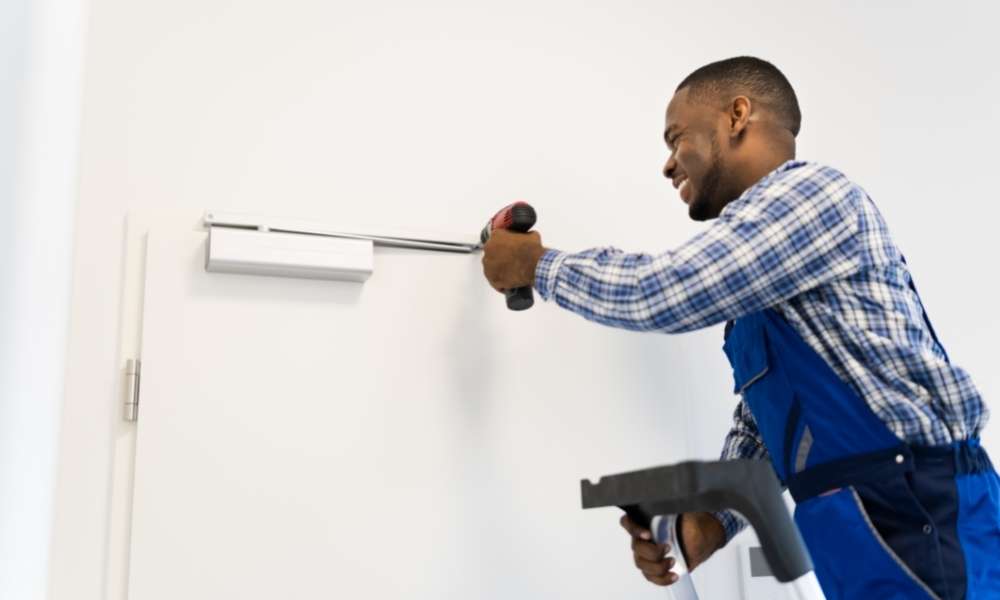Learn how to make the perfect adjustment and extend the life of your commercial door closers. How to adjust Commercial Door Closer, is a very difficult question and task these days.
If you have a large building where a lot of people go, be it a hospital, hotel, fire station, etc., you probably have a door closer. Chances are that you have encountered a situation where it needs some adjustment but you don’t know how to do it, and you are afraid of damaging the device.
The solution is definitely here, not only will you learn how to make the perfect adjustment but also how to properly maintain it.
What is a Commercial Door Closer?
First, you got to be familiar with what is a door closer. A door closer is a hardware device with the common function of controlling door movement. By using a simple hydraulic mechanism to automatically close and lock the door after each use.
This helps keep the home safe and reduces the amount of conditioned air escaping through the door. Some doors closers are small models for residential use. Users can adjust the door closer to control how fast it closes and locks.
Main Door Closer adjustme

As the first step, you must do to identify what type of door closer you have to make the proper adjustment. Meanwhile, depending on your model of door closer, there are different adjustments you can make.
Spring Power | Adjust Door Closer
The spring power adjustment is the internal spring inside the door’s closer body. Commonly, some doors closer do not have tension adjustment for the spring. Most adjustable spring power feature allows changing the tension of the spring.
As mentioned above, depending on the door closer type you have will affect how you will adjust the door’s tension closer. Usually, there are two basic design types: standard and heavy-duty.
Backcheck | Adjust Door Closer
Absolutely, knowing that a door closer is an essential component of any commercial door. If you would like to have a safe and smooth closing door, you should have the maintenance of the backcheck up to date.
Back check valves and controls the restriction of hydraulic fluid. A standard door closer, two valves that close or open the hydraulic pathways. Therefore, a third valve is known as the backcheck valve.
Closing Speed | Adjust Door Closer
The closing speed or the sweep adjusts the speed of the closing door. Closing speed depends on the closing to latch correctly.
Commonly, the adjustment that holds the door shut is the door closer pressure, known as the closing speed. How the door responds when fully opened depends on the amount of pressure this one needs.
The open position point must be twelfth degrees before latching. Furthermore, focus on adjusting the valve that is in the middle.
Latching Speed | Adjust Door Closer
The latching speed adjustment focuses on making 1.5-2 turns counterclockwise to obtain the desired catching speed. Besides, the latching speed could be appropriately adjusted depending on the situation.
If you have an outside door, the latch speed should close faster, and if you have to adjust a room door, it may close slowly so it does not slam.
Adjust Commercial Door Closer Like a Pro

Furthermore, door closers, tend to have two speeds that can be adjusted. The latch, or speed of movement, controls the door between 90 degrees and 10 degrees. The closing speed regulates the last 10 degrees of closing before the door locks.
Adjust the closing speed. Examine the side of the door closer body. There should be two small screws that are visible on the door closer, but not attached to the door. One is labeled “L” for lock and the other is labeled “S” for movement, or closing speed.
Use the screwdriver to tighten the two screws. Moreover, remember to make only small adjustments, as these tend to have a big impact. To speed up the door closer, turn the screw clockwise. To slow the door closer, turn the screws counterclockwise. You can adjust one or both speeds as needed until they are at the recommended level of 4 to 6 seconds combined.
Assists in closing a heavy door. Therefore, some large doors may not close properly if the door closer does not have the recommended settings. If the door is not closing all the way or does not latch properly, turn the closing speed clockwise gradually until the door latches properly. It is not necessary to adjust the speed of movement to match the closing speed in this step.
Get Professional Assistance

Now that you know the correct process, you can start adjusting in the best way. However, if you still have double thoughts if you are going to do it in the proper way, hire professionals.
At Chicago Door People, we count years of experience in the commercial doors industry, we are your best option in town. Our expert team will provide you with the best commercial door repair service.
Remember, in order to have a good lifespan, a good installation must be made. Get in touch with us and have our experts provide you with a free quote. Do not hesitate more and give us a call.

